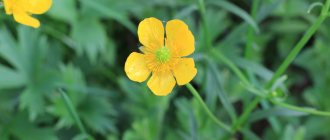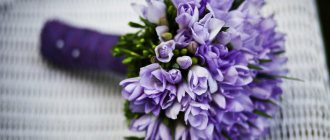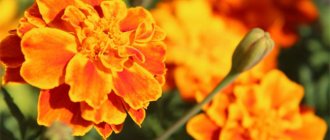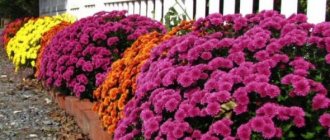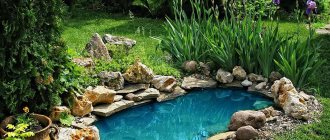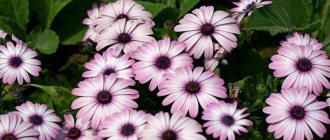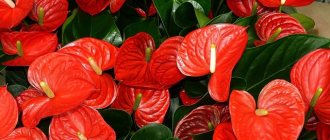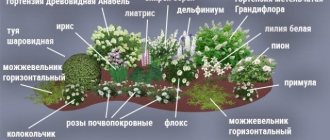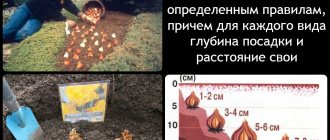The color red symbolizes energy, beauty and love. Therefore, since ancient times, flowers in fiery shades have always been woven into wreaths and planted in flower beds. Times have changed, but this color is still popular in garden design. It is actively used to complement flower beds, make bright accents on the site, and highlight landscape areas. We suggest studying the best red perennials, which stand out for their originality, can harmoniously complement the territory, and add bright accents to the area.
Primrose
A common option for flower beds is primrose. Red perennials come in different varieties, and there are also annuals. Stemless primrose is cultivated more often than others. It blooms from April to July with lush inflorescences with many flowers.
In polyanthus primrose, the red petals are contrasted by a bright yellow center. This variety blooms in May–June.
Perennials with red foliage
The original red perennials are those that do not have fiery-colored flowers, but leaves. They are able to complement any flower bed, making it more rich and presentable. The most popular are:
Blood red Heuchera
The leaves of this garden crop are distinguished by reddish-green shades.
The plant is ideal for combination with various decorative plantings in green tones.
Extravagant Coleus
This culture looks great in garden beds, various flower beds, and containers.
A very decorative Coleus Blume, which has large-toothed burgundy leaves. Crimson Ruffles also looks beautiful with raspberry-burgundy leaves.
Amaranth
These plants are an ideal solution for planting next to ornamental cabbage.
They prefer light, fertile soils and perfectly complement various types of garden plots.
Red perennials are flowers that will add a pop of color to any area. If you choose undemanding but presentable plants, you will be able to form unrealistic compositions that will make any area extraordinary and sophisticated.
Celosia
The heat-loving crop is considered exotic, so it is rarely grown even in the middle zone.
Characterized by the following features:
- branched erect stem;
- long, wide leaves lanceolate or ovoid in shape;
- flowers are located on the stem or in the axils of the leaf blade;
- fruit – capsule with a diameter of 3-4 mm;
- height 30-90 cm.
Celosia blooms in early July; under favorable conditions, the inflorescences last until October. The culture can be used to make bouquets of dried flowers.
In our climate, herbaceous forms are more common, because shrubby perennials die during frosts.
Red varieties of celosia:
- Plumosa;
- Christata;
- comb;
- Atropurpurea;
- Impress;
- Pampas;
- Feuerfeder et al.
The plant is edible; its young shoots and leaves can be added to salads. Celosia is used in folk medicine.
Poppy
Among the red flowers for the flower bed, the garden poppy stands out with its bright scarlet inflorescences. Description of culture:
- herbaceous plant;
- tap root;
- leaves are pinnately dissected or entire, covered with bristly pubescence;
- buds are single, there are forms with paniculate inflorescences;
- flowers of regular shape with many thin stamens;
- powerful flower stalks;
- fruits are club-shaped.
By law, it is prohibited to grow all opium poppy varieties on a personal plot. Failure to comply with the Government Resolution is punishable by a fine of up to 300 thousand rubles. or imprisonment for up to 2 years.
Options for using low-growing flowering plants
The beautiful flowering plants discussed above are planted both solo and in mixed groups. There are many options and planting patterns.
Design of borders along paths
White alyssum and violas may not be too original, but they create a bright ensemble and a joyful mood
A path from the gate to the house accompanied by marigolds is a good option for a summer residence
Container flower beds
Since almost all low-growing annuals are suitable for growing in container culture, in addition to stationary flower beds on the site, they are often planted in pots, flowerpots, boxes, including hanging ones. It turns out to be a kind of movable, mobile flower bed, which can be conveniently placed near the house, on an external windowsill, in a gazebo, on a terrace or in a garden.
Ampelous petunias become a bright element of the decor of the local area and recreation areas
A wide variety of household containers can be used as containers: barrels, bathtubs, basins, tubs, watering cans, buckets - there are many ready-made ideas. Why not implement them on your site?
Mini flower garden in Russian style on the grass - alyssum, marigolds and viola flaunt in a high metal basin
Original flower beds
Low flowers can set the tone for the entire composition, especially if there is a general idea in its composition.
Blue and blue lobelia, white alyssum create the effect of sea foam on the water flow from an overturned large ceramic pot
Low-growing perennial flowers for the flower bed form a single composition with medium and tall plants.
The bluebells in the foreground harmonize well with summer dahlias, snapdragons and echo the delphinium
Rockeries
Stone gardens, alpine slides, rock gardens require special efforts precisely at the planning and creation stage. The floristic component plays a leading role.
The main accent of the composition is rock alyssum
Mostly perennial plants are planted among the stones, but properly selected, abundantly flowering annuals will add a touch of freshness.
Curtains of blue and blue lobelia, white and lilac alyssum create the effect of a stream flowing over the stones
Petunia
These beautiful flowers for a flower bed are hard to miss.
The most popular varieties with red inflorescences:
- Aladdin Red - blooms early, this petunia is rain resistant. The flowers are large, the petals have corrugated edges. Bush up to 30 cm high, compact, full.
- Capri Red blooms from spring to autumn. Withstands temperatures from -4 to +40 degrees. The variety is resistant to adverse weather conditions.
- Valentina is a double petunia that resembles a carnation. Plant up to 40 cm high, branched bush.
- Supercascading red is characterized by upward growing seedlings that later fall under the weight of numerous flowers.
Nasturtium
No one will remember when nasturtium first appeared in our gardens, but it has clearly settled here for a long time. A bright and absolutely unpretentious plant will decorate a garden of any style; it will grow in a flowerbed, in a pot, in almost any soil.
Dwarf, bush and liana-like varieties of nasturtium have one thing in common - it does not overwinter in our latitudes, but it blooms until cold weather. At the end of May, nasturtium is sown directly into the ground, leaving a distance of 25-30 cm between the seeds. Liana-like varieties are immediately supported or sown near trellises, pergolas, arbors, etc. Caring for flowers consists of abundant watering, weeding and regular application of potassium-phosphorus fertilizers, until the beginning of flowering.
Godetia
The so-called California rose belongs to the family of Fireweed annuals. A plant with a straight, branched, highly pubescent stem and linear-lanceolate leaves, tolerates cold weather well. The bush is spreading or looks like a narrowed pyramid.
The flowers are large and can be single or double. The inflorescence is 3-10 cm in diameter, collected from bell-shaped buds.
How to properly design flower beds with conifers: the best compositions and combinations of plantsAnnual flowers for a flower bed or garden: photos with names
Bush hibiscus: photo, planting and care features
Korean chrysanthemum
Red garden flowers grow on a compact or spreading bush with straight stems. The leaves are similar in shape to oak leaves, gray-green in color, pubescent, and have a specific smell.
Cold resistance is high, oak trees can even withstand the first snow. The perennial is cultivated throughout the country.
Phlox
There are many types and varieties of phlox. The following varieties are distinguished by red inflorescences:
- Margarita has flowers with a diameter of 4 cm that do not fade in the sun. The height of an adult plant is 75 cm.
- Odile has flowers with a diameter of 3.5 cm, the purest red hue of all phloxes, the inflorescence is dense and embossed. The bush is semi-spreading, with strong stems, 90 cm high.
- Ivan-Zarya is characterized by large inflorescences. The flowers are 3.8 cm in size and star-shaped. Plant height 90-100 cm.
Cosmea
Annual and perennial plants of the Asteraceae family. The shoots are numerous, green, with reddish veins, some grow up to 1.5 m tall.
Flowering lasts up to 3 months, starting from June – July. The inflorescences are paniculate, up to 12 cm in diameter. Cosmos is unpretentious in care.
Bloodroot
Also known as five leaf tea and Kuril tea. Cinquefoil is a medicinal plant and is used in folk medicine. Garden varieties can be short, growing up to only 20 cm. There are also bushes up to 1 m tall. The culture is unpretentious, but does not tolerate shade and drought.
Popular red varieties:
- Marion Red Robin;
- Ace;
- Gibson Scarlet;
- Joker.
Pelargonium
Many people confuse zonal pelargonium with geranium, but they are not the same plant. It is suitable for both outdoor and indoor growing, blooms beautifully and for a long time, and looks great in group plantings and flowerpots.
The easiest way to propagate pelargonium is by cuttings; the seeds are sown for seedlings in March, but there is another way to deceive nature. Typically, in our latitudes, pelargonium is grown as an annual, but if you dig it up in the fall, shorten the roots and immerse it in a pot with moist soil, and periodically water it in winter and store it in semi-darkness, then in the spring it will be ready to return to the flowerbed. Pelargonium loves direct sunlight, watering with warm, settled water and timely removal of faded brushes.
Helenium
It can be an annual or perennial. Helenium grows up to 1.6 m. The stems are straight, branching at the top. Leaves are lanceolate, alternate. The flowers are solitary, consisting of inflorescences-baskets. The core is pronounced, the petals border it in the form of a bright skirt.
The crop is sun-loving and grows well in fertile soils. Helenium is unpretentious in care.
Red varieties:
- Rubinzverg;
- Salsa;
- Sombrero;
- Ruby Tuesday;
- Hot lava.
Tall perennials with red flowers
If we have figured out the formation of borders, now we should think about how large areas on the site and mixborders will be decorated. The ideal solution in this case would be to use tall representatives with fiery petals. Let's look at the brightest red perennials.
Heleniums or red chamomile perennials
Helenums are tall red perennials that belong to the Asteraceae family. The homeland of such cultures is considered to be the territory of Eastern America. The height of specimens can reach up to 1.6 meters. The stem can be smooth, branched or straight. The leaves are usually lanceolate in shape and do not develop chaotically, but in order of priority.
Helenium usually forms a hemisphere, enveloped in yellow pollen. The central part is framed by circular petals. Visually, they resemble chamomile, hence the second name for heleniums.
Stem height up to 0.9 meters. Flowering can be observed within 5-6 weeks. These perennials will delight you with their fiery flowers from late summer to early autumn. When flowering ends, cylindrical seeds will form on the plant. In order for the bushes to develop beautifully and fully, they need to be watered abundantly and the soil well fertilized.
Exquisite Adonis or Adonis
Adonis is a red perennial that can also be grown as an annual. The plant is actively used in landscape design and has a wide range of healing properties. Therefore, the culture is listed in the International Red Book.
Adonis forms exquisite bushes that are distinguished by their lush appearance. The petals are fiery red in color, visually similar to chamomile. This flower is up to 3 cm in diameter. The total number of species is up to 32. Flowering lasts throughout the whole summer. To grow adonis, it is recommended to choose illuminated areas; the soil can be any kind. If the weather is excessively hot, additional watering of the bushes will be required.
Refined red garden perennial - Poppy
Poppy is a plant that has been familiar to many since childhood. But now, in addition to the usual variety, there are also decorative ones, with terry leaves. The height of the crops is up to 1.2 meters. To make poppies bloom continuously, you need to sow them every 10 days.
These red perennials have narrow leaves with small teeth along the edges. The flowers are created from 4 petals with two sepals. A tap root that goes deep into the ground. For growing poppies, it is better to choose areas with good lighting. Caring for the crop is not burdensome, the main thing is that it does not grow in areas with stagnant moisture or close groundwater.
Original Astilbe
Another red perennial is astilbe. These are herbaceous crops that belong to the Saxifraga family. There are more than 40 varieties of the plant, as well as about 400 cultivars. Astilbe height is up to 2 meters. The flowers form very sophisticated and attractive panicle-shaped inflorescences. Their length is up to 0.6 meters. The color varies, but the red buds deserve special attention. The Japanese astilib Montgomery is distinguished by such beauty. The height of the bushes is up to 0.7 meters, the leaves are usually reddish-brown in color. This beauty begins to bloom in the second half of July, this period lasts for 2 weeks.
When planting astilbes, remember that they do not need a lot of light rays; the ideal solution would be to plant them in light shade. This guarantees long-lasting and abundant flowering.
Lychnis chalcedony
For those looking for interesting and unusual perennials that bloom with red flowers, the sophisticated Lychnises have been bred. These crops belong to the Carnation family and are widespread throughout the Northern Hemisphere. These are rhizomatous plants, distinguished by the presence of an erect stem, its height is up to 1 meter. The leaves are oblong and create a rosette. Such crops bloom from the beginning of summer; the flowers have a thyroid shape. The corolla has a diameter of up to 2 centimeters.
Red perennials will delight you with their flowering for a month. The most popular variety with red petals is Lychnis chalcedony. Its height is up to 1 meter. Representatives have leaves of an erect type, with weak branching.
Verbena
An annual or perennial plant whose height does not exceed one meter. There are herbaceous and semi-shrub species, the stems are creeping, erect or prostrate. Dark green leaves are opposite, pubescent.
The inflorescences are paniculate or corymbose, consisting of 30-50 small flowers 1.5-2.5 cm in size. Verbena exudes a pleasant, delicate aroma. The smell intensifies in the evening hours.
Adonis
Also known as adonis, ember on fire, pheasant's eye. An annual herbaceous plant 10-50 cm high. Leaves are petiolate, basal, 3-5 cm in size. Flowers are 2-3 cm in diameter, each with about 230 purple-black stamens.
The plant is toxic; it is unacceptable to grow near playgrounds and places where pets are kept.
You can get a bright and lush flower bed by planting red flowers on it. They should be selected depending on the climate zone and external features.
Aster
The variety of varieties of annual asters is so great that it is difficult to make a choice. Bushes can be from 20 to 120 cm in height, with a variety of leaves, crown and flower shapes.
When choosing seeds, check their freshness - already in the second year after collection they lose up to 60% of their germination capacity. Asters are grown both through seedlings (in March-April) and immediately in open ground, under film cover. Flowers react positively to transplanting and picking, so you don’t have to be afraid to move them around the site. Asters do not tolerate stagnant moisture and fertilization with fresh manure.
